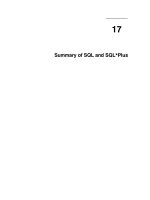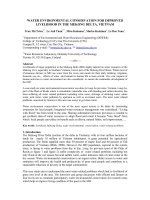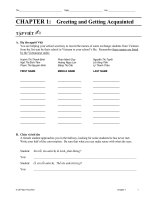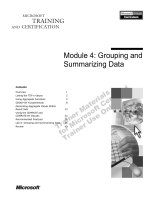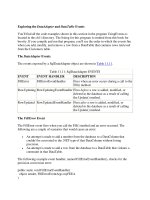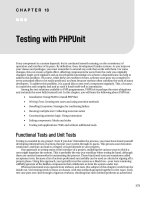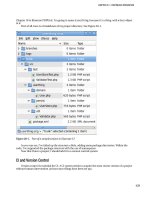Tài liệu Design Discourse - Composing and Revising Programs in Professional and Technical Writing doc
Bạn đang xem bản rút gọn của tài liệu. Xem và tải ngay bản đầy đủ của tài liệu tại đây (1.7 MB, 342 trang )
DESIGN
DISCOURSE
Composing and Revising
Programs in Professional
and Technical Writing
Edited by
David Franke
Alex Reid
Anthony DiRenzo
DESIGN DISCOURSE
D D: C R P P
T W addresses the complexities of developing profes-
sional and technical writing programs. The essays in the collection offer re-
flections on efforts to bridge two cultures—what the editors characterize as
the “art and science of writing”—often by addressing explicitly the tensions
between them. D D offers insights into the high-stakes deci-
sions made by program designers as they seek to “function at the intersection
of the practical and the abstract, the human and the technical.”
David Franke teaches at SUNY Cortland, where he served as director of the
professional writing program. He founded and directs the Seven Valleys Writ-
ing Project at SUNY Cortland, a site of the National Writing Project.
Alex Reid teaches at the University at Buffalo. His book, T T V:
N M C, received honorable mention for the W. Ross
Winterowd Award for Best Book in Composition Theory (2007), and his blog,
Digital Digs (alex-reid.net), received the John Lovas Memorial Academic We-
blog award for contributions to the field of rhetoric and composition (2008).
Anthony Di Renzo teaches business and technical writing at Ithaca College,
where he developed a Professional Writing concentration for its BA in Writing.
His scholarship concentrates on the historical relationship between profes-
sional writing and literature.
P W
Series Editor, Michael Palmquist
The WAC Clearinghouse
3015 Brackenberry Drive
Anderson, SC 29621
www.parlorpress.com
S A N: 2 5 4 - 8 8 7 9
ISBN 978-1-60235-167-7
Franke
Reid
DiRenzo
DESIGN DISCOURSE
WAC
CLEARING-
HOUSE
PARLOR
PRESS
PERSPECTIVES ON WRITING
Series Editor, Mike Palmquist
PERSPECTIVES ON WRITING
Series Editor, Mike Palmquist
e Perspectives on Writing series addresses writing studies in a broad sense.
Consistent with the wide ranging approaches characteristic of teaching and
scholarship in writing across the curriculum, the series presents works that take
divergent perspectives on working as a writer, teaching writing, administering
writing programs, and studying writing in its various forms.
e WAC Clearinghouse and Parlor Press are collaborating so that these books
will be widely available through free digital distribution and low-cost print
editions. e publishers and the Series editor are teachers and researchers of
writing, committed to the principle that knowledge should freely circulate.
We see the opportunities that new technologies have for further democratizing
knowledge. And we see that to share the power of writing is to share the means
for all to articulate their needs, interest, and learning into the great experiment
of literacy.
Existing Books in the Series
Charles Bazerman and David R. Russell, Writing Selves/Writing Societies (2003)
Gerald P. Delahunty and James Garvey, e English Language: from Sound to
Sense (2010)
Charles Bazerman, Adair Bonini, and Débora Figueiredo (Eds.), Genre in a
Changing World (2009)
David Franke, Alex Reid, and Anthony Di Renzo (Eds.), Design Discourse:
Composing and Revising Programs in Professional and Technical Writing (2010)
DESIGN DISCOURSE:
COMPOSING AND REVISING
PROGRAMS IN PROFESSIONAL
AND TECHNICAL WRITING
Edited by
David Franke
Alex Reid
Anthony Di Renzo
e WAC Clearinghouse
wac.colostate.edu
Fort Collins, Colorado
Parlor Press
www.parlorpress.com
Anderson, South Carolina
e WAC Clearinghouse, Fort Collins, Colorado 80523-1052
Parlor Press, 3015 Brackenberry Drive, Anderson, South Carolina 29621
© 2010 David Franke, Alex Reid, and Anthony Di Renzo. is work is licensed under
a Creative Commons Attribution-Noncommercial-No Derivative Works 3.0 United States
License.
Library of Congress Cataloging-in-Publication
Design discourse : composing and revising programs in professional and technical writing /
edited by David Franke, Alex Reid, Anthony DiRenzo.
p. cm.
Includes bibliographical references.
ISBN 978-1-60235-165-3 (pbk. : alk. paper) ISBN 978-1-60235-166-0 (hardcover : alk.
paper) ISBN 978-1-60235-167-7 (adobe ebook : alk. paper)
1. English language Rhetoric Study and teaching (Higher) United States. 2. Academic
writing Study and teaching (Higher) United States. 3. Technical writing Study and teach-
ing (Higher) United States. 4. Writing centers Administration. I. Franke, David, 1960- II.
Reid, Alex, 1969- III. DiRenzo, Anthony, 1960-
PE1405.U6D47 2010
808’.0420711 dc22
2010001091
Copyeditor:
Annabelle Bertram
Designer: David Doran
Series Editor: Mike Palmquist
e WAC Clearinghouse supports teachers of writing across the disciplines. Hosted by Colo-
rado State University, it brings together scholarly journals and book series as well as resources
for teachers who use writing in their courses. is book is available in digital format for free
download at .
Parlor Press, LLC is an independent publisher of scholarly and trade titles in print and
multimedia formats. is book is available in paperback, cloth, and Adobe eBook formats
from Parlor Press on the World Wide Web at . For submission
information or to nd out about Parlor Press publications, write to Parlor Press, 3015 Brack-
enberry Drive, Anderson, South Carolina 29621, or e-mail
is volume is dedicated to all those who are delighted by the
study, teaching, and practice of writing.
vii
Contents
Preface ix
Composing 3
1 e Great Instauration: Restoring Professional and
Technical Writing to the Humanities 5
Anthony Di Renzo
2 Starts, False Starts, and Getting Started:
(Mis)understanding the Naming of a Professional Writing Minor 19
Michael Knievel, Kelly Belanger, Colin Keeney, Julianne Couch,
and Christine Stebbins
3 Composing a Proposal for a Professional / Technical Writing Program 41
W. Gary Griswold
4 Disciplinary Identities: Professional Writing,
Rhetorical Studies, and Rethinking “English” 63
Brent Henze, Wendy Sharer, and Janice Tovey
Revising 87
5 Smart Growth of Professional Writing Programs:
Controlling Sprawl in Departmental Landscapes 89
Diana Ashe and Colleen A. Reilly
6 Curriculum, Genre and Resistance: Revising Identity in a Professional
Writing Community 113
David Franke
7 Composing and Revising the Professional Writing Program
at Ohio Northern University: A Case Study 131
Jonathan Pitts
Contents
viii
Minors, Certificates, Engineering 151
8 Certicate Programs in Technical Writing: rough Sophistic Eyes 153
Jim Nugent
9 Shippensburg University’s Technical / Professional Communications
Minor: A Multidisciplinary Approach 171
Carla Kungl and S. Dev Hathaway
10 Reinventing Audience through Distance 189
Jude Edminster and Andrew Mara
11 Introducing a Technical Writing Communication Course
into a Canadian School of Engineering 203
Anne Parker
12 English and Engineering, Pedagogy and Politics 219
Brian D. Ballentine
Futures 241
13 e ird Way: PTW and the Liberal Arts in the
New Knowledge Society 243
Anthony Di Renzo
14 e Write Brain: Professional Writing in the
Post-Knowledge Economy 254
Alex Reid
Post-Scripts by Veteran Program Designers 275
15 A Techné for Citizens: Service-Learning,
Conversation, and Community 277
James Dubinsky
16 Models of Professional Writing / Technical Writing Administration:
Reections of a Serial Administrator at Syracuse University 297
Carol Lipson
Biographical Notes 317
ix
Preface
David Franke
is book grew out of the challenges of starting and sustaining a Profes-
sional and Technical Writing program at the state college where Alex Reid and
I were hired (nearby, co-editor Anthony Di Renzo began his program at Ithaca
College in New York a few years before us). We found ourselves building our
program at the intersection of several academic and semi-academic discourses—
rhetoric, English, new media, business, publishing, composition and others.
We had plenty of theory from these elds and personal experience as students,
teachers, writers, and freelancers. Yet as we established our identity as a major,
we found that our interactions with other departments (especially English), our
entanglement with the long-standing academic tensions between “liberal” and
“vocational” education, the demands of staying abreast of new technology, the
way our resources and students were distributed across many disciplines—all
these pressures and others combined in unexpected ways, presenting us with a
bit of a paradox in that we were compelled to make sense of the whole while we
struggled with the day-to-day work of running a new program; simultaneously,
most day-to-day decisions depended on a sense of our whole—our mission,
rhythms, audiences, and strengths. Seen from a purely analytical perspective,
what we were trying to do seemed impossible.
But of course it wasn’t impossible. Our experience beginning a PTW
program at the State University of New York at Cortland was typical in many
ways. e undergraduate program we were hired to bring to fruition, like many
others, was simply hard to dene, lacking a deep sense of tradition that English
and even rhetoric programs often enjoy. Our program was dened more by what
it was not than what it was: not literature, not journalism, not composition. De-
spite this, the program grew, in part because we were able to invent an attractive
curriculum, and our success introduced a new problem in that we were quickly
understaed: we had only three Professional and Technical Writing faculty in an
English department of 50-odd full-time and part-time faculty. e demands on
the three of us, all in new jobs, were sometimes intimidating. Actually, they were
often overwhelming, as several authors in this volume have also experienced in
their own schools. In front, we met the challenge of teaching new classes. At our
back was an avalanche of paperwork. Struggling to keep moving forward, we
found ourselves grasping for information and models. Like any academic in a
new situation, we depended on our research skills rst, and started reading.
1
e
WPA (Writing Program Administrator) listerv ( />Design Discourse
x
wpa-l.html) gave us valuable clues to how writing programs run on a day-to-
day basis, though its focus is of course more on Freshman English. National
conferences, especially ATTW (Association of Teachers of Technical Writing)
and CPTSC (Council on Programs in Technical and Scientic Communica-
tion), provided invaluable information about internships, key courses, recent
theory—and at these conferences we found something the readings did not pro-
vide: warm, anecdotal, human stories. I sought rst-person narrative accounts
that presented the PTW administrator’s logic and commitments, a constructive,
sustained, intelligent set of discussions in relation to which we could shape our
own history. To complete and understand our own program, we needed reective
stories that demonstrated and reected on the process of making key, high-stakes
decisions in the unfamiliar situation of running a professional writing program.
is narrative gap is what prompted my colleague Alex Reid and me
to put out a call for papers that would, we hoped, assemble a community of
narratives. Alex and I asked that PTW curriculum designers discuss how they
composed and revised their PTW sites. We emphasized that we were looking
for case studies in rst person that revealed how designers made sense of and
organized their particular location—in other words, how they historicized their
work. eir stories would reveal the praxis of those in PTW programs work-
ing simultaneously as both teachers and administrators, often from the margins
of English, Engineering, Composition/Rhetoric, and on the line between the
liberal arts and professional schools. e focus was not to be pedagogical, but
architectural, with an emphasis on design problems.
In its nal form, each of the essays was to examine the complexities of
developing, sustaining, or simply proposing non-literature curricula, from entire
programs to individual classes. e authors were generally new assistant professors
when these essays were written, and their contributions reect an acute sensitivity
to the practical contexts within which they worked—the political, historical, and
nancial realities—as well as a sense of vitality, a sense that something untested
and unique could emerge and succeed at their respective locations. In the best
pragmatic tradition, these essays explain how to both picture and perform a task,
in this case the task of developing communities and curricula in PTW, with the
belief that other designers might benet from their narratives.
We experimented in this volume. Our always-supportive publisher
Mike Palmquist encouraged us to go ahead with a form of peer review that
helped us make the entire process as useful as possible to the authors and you,
the book’s audience. After outside readers gave the thumbs up to the book pro-
posal, we solicited the essays. Alex Reid and I wrote responses to each essay we
accepted and mailed our comments back to the author. Simultaneously, each es-
say was mailed to another contributor in the book for further response and com-
xi
Preface
ments. e results were strongly positive. Invested in the volume, peers generally
commented critically and generously on one another’s work and appreciated the
additional feedback they received while revising. Doing so also helped contribu-
tors minimize overlap with other essays and gain a better picture of the volume
as a whole. Conscious that many of our contributors are new to the eld, we also
invited several well-known gures in the eld to read a grouping of essays and
write “Post-Script” pieces based on their experience as program designers. Michael
Dubinsky and Carol Lipson, experienced members of the eld, graciously agreed
to reect on their careers in a way that gives context to the essays collected here.
Many of the articles collected here address what Robert Connors calls
the “two-culture split” between the art and science of writing. at is, many of
us struggle with practical answers to a question asked in various ways: are we to
encourage insight or technique, liberal or vocational education, good citizens or
good workers? is question is of course addressed by our theory, but has to be
confronted also in even the most bureaucratic decisions about program require-
ments, a semester’s course oerings, or even class sizes. is tension is also pres-
ent every time a PTW faculty member sits down to write for publication. What
balance does one provide for the reader between theoretical speculation and
practical orientation? To put it another way, when we write for our colleagues in
PTW, are we to provide interesting questions or interesting answers, the prob-
lematics of a course of inquiry or the results of a course of action?
e chapters here provide both, taking a stance that bridges the two
cultures and often explicitly addresses the tensions between them. Faculty un-
der the gun to organize a program do not have the luxury of waiting for the
conclusion of big-picture arguments about the history, nature, and status of
the eld; likewise, short-term best-guess decisions won’t sustain a program for
very many semesters. Bringing together problem posing and problem solving is
exactly what a program designer must do in order to begin and sustain his or her
PTW program. is both/and thinking has direct application to the students’
learning. e PTW programs here refuse to choose between teaching students
to reect or teaching them the skills to “succeed” – with “success” a term that
teachers tend to think about even more critically than their students.
e 16 essays of Design Discourse are arranged in ve sections. e rst
four chapters are grouped together under the heading of “Composing.” Anthony
Di Renzo’s “e Great Instauration” addresses the practical and rhetorical chal-
lenges of setting up a PTW program in the humanities, addressing the chronic
tension between liberal and practical arts. Drawing from Francis Bacon’s Ad-
vancement of Learning in the opening essay, Di Renzo provides a theoretical and
ethical framework in which “technical” subjects can serve as sites for the devel-
opment and improvement of “social good.” Di Renzo (like Bacon) appreciates
Design Discourse
xii
the practical uses of knowledge, and eloquently turns Bacon’s insights to prag-
matic advice for those facing the challenge of beginning and beyond. Turning
then to the concerns at a specic site, collaboratively written “Starts, False Starts,
and Getting Started: (Mis)understanding the Naming of a Professional Writing
Minor” (Michael Knievel, Kelly Belanger, Colin Keeney, Julianne Couch, and
Christine Stebbins) historicizes the process of naming their minor as it unfolds
at their particular institution over several decades. By tracing the various impli-
cations of their program’s name, they present a nuanced study of how various
stakeholders choose to interpret—and misinterpret—their program. ey pres-
ent the process of naming as an inquiry, guided by a set of ethical and practical
questions, into their identity and audience: “are these expectations [raised by the
program’s name] at odds with each other? Which expectations can realistically
be met given resources like faculty, funding, and goodwill?”
Two other articles in this rst section discuss the process of designing in
PTW in the face of serious challenges. As W. Gary Griswold puts it in “Compos-
ing a Proposal for a Professional / Technical Writing Program,” writing the RFP
(Request For Proposals or grant) for his program was a matter of “one week and
ve pages.” A case study of the under-represented (and over-feared) process of
submitting a grant application, Griswold’s essay includes the original request for
proposals and his response.
Completing this section, Brent Henze, Wendy Sharer and Janice Tovey’s
piece on “Disciplinary Identities: Professional Writing, Rhetorical Studies, and
Rethinking ‘English’” narrates their attempt to establish their proposed program
in Rhetorical Studies and Professional Writing. e proposal itself was not well
received. As they put it, they had inadvertently “thrown open the oodgates of
disagreement about what a degree in ‘English’ means.” eir candid narrative
examines with equanimity not only the choices they made, but also what they
might have done dierently, making it useful to program designers who simi-
larly have to traverse disputed academic territory.
“Revising,” the second section of Design Discourse presents strategies
for sustaining PTW programs. In “Smart Growth of Professional Writing Pro-
grams: Controlling Sprawl in Departmental Landscapes,” Diana Ashe & Col-
leen A. Reilly develop an extended metaphor that draws on “systems thinking”
from ecotheory and “smart growth” from city planning, using these schools of
thought to guide their program’s development. eir model promotes interde-
pendence, change, and diversication as key principles that shape “sustainable
and resilient programs.” Presenting their attempt to strike a balance between
specialization or succumbing to “the academic equivalent of urban sprawl,” Ashe
and Reilly’s essay shows how a program can be both dynamic and principled as
it develops an identity over time and in concert with various academic commu-
xiii
Preface
nities. My own essay studies change in our undergraduate PTW program in a
small New York college. I draw from genre theory, which argues that established
types of written texts, though they may appear “frozen” or inert, are in fact pow-
erful and dynamic forces shaping a community. Yet I began the program with a
fairly naïve understanding of how the curriculum-as-genre, as a published docu-
ment, would function. I describe learning to work with that curriculum as an “en-
abling constraint,” one that pushed us to evolve while also restraining our growth.
Change is also the theme of Jonathan Pitts’ “Composing and Revising the Pro-
fessional Writing Program at Ohio Northern University: A Case Study. Charged
with developing, sustaining, and creating coherence for his nascent major, Pitts
shows how he deliberately planned for change without sacricing coherence. His
chapter includes the specic course oerings in his program and a vivid narrative
of his experiences; it concludes with snapshot essays of several graduates from his
program. In “Foundations for Teaching Technical Writing,” Sherry Burgus Little
explains that the “design and development” of certicate programs “crystallizes”
the pervasive and long-standing debate over the ends of education (283). ey
inevitably raise questions about what sorts of knowledge is essential for students
to do their work as PTW professionals.
e chapters in the third section of this book, “Minors, Certicates,
Engineering,” certainly conrm Little’s insight. ough smaller than four-year
undergraduate programs, these more concentrated sites introduce signicant ar-
guments to this volume, posing special problems for the program administrator.
First in this section, Jim Nugent’s essay “Certicate Programs in Technical Writ-
ing: rough Sophistic Eyes,” the result of a survey of 62 certicate-granting
sites, nds contemporary programs value “situated and contingent” knowledge
that is both exible, reective, and socially engaged. Carla Kungl and S. Dev
Hathaway present an adroit response to the pressure to professionalize in “Ship-
pensburg University’s Technical/Professional Communications Minor: A Mul-
tidisciplinary Approach.” Recognizing the pressures on academic institutions to
develop a “practical” writing degree, but lacking the resources or students to sus-
tain a full-edged program, they show how an interdisciplinary minor can gain
a foothold. eir essay reveals how they juggle competing educational goals in
their college, creating a “career-enhancing program for students while maintain-
ing a meaningful liberal arts backdrop.” Similarly, Jude Edminster and Andrew
Mara in “Reinventing Audience through Distance” discuss the development of a
program tailored to their situation, one with a large number of international stu-
dents yet lacking local high-technology jobs. eir creative solution is to create
a graduate certicate program that meshes with the graduate programs in Scien-
tic and Technical Communication at Bowling Green State University. Rather
than trying to prepare students for every specic technical task, these faculty
Design Discourse
xiv
teach their students to make decisions situationally. ey draw from omas
Kent and post-colonialist theory to articulate their approach, one in which stu-
dents learn to “participate in meaning-making and to recognize their role in
meaning-making.”
e relationship between the humanities and the sciences is developed
in Anne Parker’s reective essay, “Introducing a Technical Communication
Course Into a Canadian School of Engineering: A Case Study of the Professional
and Academic Contexts.” ere, she discusses developing a coherent and persua-
sive model for teaching writing that draws on the habits of thought internalized
by engineering. Holding a position on the faculty in the Engineering school, she
presents working as an “insider” to eect change there. Her chapter tacitly traces
strategies for dealing with a complex and gendered institutional context. She
also gives a helpful and detailed discussion of how to keep various elements of
her course vital and interactive: her team, the collaborative process, and product.
Also concerned with Engineering, Michael Ballentine of Case Western Univer-
sity shows us a successful approach for developing a writing pedagogy for engi-
neers at his university. Dealing both with the graduate practicum course and the
particular course for engineers that it prepares teachers for (over 350 students
take it each year!), his “English and Engineering, Pedagogy and Politics” dis-
cusses the political and practical negotiations necessary to embed successfully an
engineering program into an English department.
e penultimate section of the book, “Futures,” is composed of two
forward-thinking essays: “e ird Way: PTW and the Liberal Arts in the New
Knowledge Society” by Anthony Di Renzo and “e Write Brain: Professional
Writing in the Post-Knowledge Economy” by Alex Reid. Di Renzo’s essay ar-
gues that PTW programs are a much-needed bridge for educational institutions
torn between traditional liberal arts educational values and new pre-professional
imperatives. PTW can provide an urgently needed social service by graduating
rhetors with the know-how and eloquence to communicate between the vari-
ous professions and disciplines, adept at responding to the demands of the new
knowledge economy. Di Renzo’s essay is essentially promoting a new image of
what an “educated person” might look like, free of an aected disdain for world-
ly aairs or for intellectual play, and he argues persuasively that PTW programs
are an apt site in which to begin education’s “third way.”
Likewise, Alex Reid’s piece entitled “e Write Brain: Professional Writ-
ing in a Post-Knowledge Economy” conrms the centrality of technology for all
PTW programs, placing it at the intersection of human and technical concerns.
at is, Reid advocates for developing technical educational programs that draw
from a vast range of intellectual and creative skills. He argues that several inu-
ences compel PTW programs to re-think their programs: the “knowledge econ-
xv
Preface
omy” that has gone “oshore”; the consequent need for writers with rhetorical
and critical skills; the rise of new Web 2.0 technologies which demand we teach
students how to think “in” new media; the linked demands that Web 2.0 puts on
us as faculty to teach and use such media to build knowledge webs and the like
(Reid mentions wikis, blogs, and podcasts along with del.icio.us and ickr.com).
His is not a repudiation of the humanistic, rhetorical tradition, but a reinscrip-
tion of it (or “remediation” as Jay David Bolter might have it), accomplished in
new media. Reid gives us a conceptual and pragmatic sketch of how these sea
changes can and will aect our working lives in PTW programs.
Finally, in “Post Scripts” we have reections from two experienced pro-
gram designers, Carol Lipson of Syracuse University and Jim Dubinsky of Virgin-
ia Polytechnic Institute and State University. Dubinsky’s “A Techné for Citizens:
Service-Learning, Conversation, and Community” reects on the decade-long
process of creating an undergraduate PTW curriculum that is both practical and
reective, rewarding not only for the student but also for the student’s communi-
ty. He lays out the choices, both theoretical and practical, of designing a program
that supports constructive civic action. e goal here is setting up students who
can work with others on common problems, a harmony he likens to a form of
reverence. Developing detailed and workable solutions to common problems is
both a humanistic and technical commitment in Dubinsky’s program, articulated
clearly in this helpful reective essay. Whereas Jim Dubinsky’s essay addresses the
process of getting up to interstate speed, Carol Lipson’s reective essay “Models
of Professional Writing/Technical Writing Administration: Reections of a Serial
Administrator at Syracuse University” traces her journey through several dier-
ent incarnations of professional and technical writing, stretching nearly three
decades, at Syracuse University in New York. Her experience clearly contrasts
two paradigms. In the rst, program leaders are segregated and pursue somewhat
independent paths in a clearly dened hierarchy; in the second, the leaders of
various initiatives are (ideally) peers who share a complex and intertwined set of
partially overlapping agendas. Hierarchy is less explicit, if not absent. Lipson’s
essay is candid about the complex institutional and administrative challenges
that faced her as a PTW program designer, and gives a trajectory of her academic
career which new PTW leaders will nd useful and interesting.
We believe new program designers engaged in the process of sowing and
cultivating their own programs will nd in this volume’s narratives something par-
allel to a reective community, one that can help them develop their own pro-
gram’s identity, habits, and goals. We believe PTW programs can and do function
at the intersection of the practical and the abstract, the human and the technical. It
is our hope that the essays reveal these binaries working dialectically for the better.
Design Discourse
xvi
1
We found the following texts particularly helpful: Katherine Adams’ A His-
tory of Professional Writing Instruction in American Colleges: Years of Acceptance,
Growth, and Doubt (Southern Methodist U.P., 1993); Teresa C. Kynell and Mi-
chael Moran’s collection ree Keys to the Past: e History of Technical Commu-
nication (ATTW, 1999); New Essays in Technical and Scientic Communication:
Research, eory, and Practice, edited by Paul Anderson, R. John Brockman, and
Carolyn Miller (Baywood, 1983); Katherine Staples and Cezar Ornatowski’s
Foundations for Teaching Technical Communication: eory, Practice, and Program
Design (ATTW, 1998); Coming of Age: e Advanced Writing Curriculum, edited
by Linda K. Shamoon, Rebecca Moore Howard, Sandra Jamieson and Robert A.
Schwegler (Boynton/Cook Heinemann, 2000).
Bolter, Jay David, Writing Space: Computers, Hypertext, and the Remediation of
Print, Second Edition. Mahwah: Lawrence Erlbaum Associates, 2001.
Conners, Robert J. “Landmark Essay: e Rise of Technical Writing in America.”
In ree Keys to the Past: e History of Technical Communication. Teresa C.
Kynell and Michael G. Moran. Vol. 7 ATTW Contemporary Studies in Tech-
nical Communication. Ablex: Stamford, CT., 1999. 173-195.
Little, Sherry Burges. “Designing Certicate Programs in Technical Writing.” In
Foundations for Teaching Technical Communication: eory, Practice, and Pro-
gram Design. Katherine Stapes and Cezar Ornatowski, eds. Vol. 1, ATTW
Contemporary Studies in Technical Communication. Ablex: Greenwich, CT.,
1997. 273-285.
DESIGN DISCOURSE
5
1 e Great Instauration: Restoring Professional and
Technical Writing to the Humanities
Anthony Di Renzo
“I hold every man a debtor to his profession; from which as men of course do seek to
receive countenance and prot, so ought they of duty to endeavor themselves, by way
of amends, to be a help and an ornament thereunto. is is performed in some degree
by the honest and liberal practice of a profession . . . ; but much more is performed if a
man be able to visit and strengthen the roots and foundation of the science itself.”(546)
Sir Francis Bacon, “Preface,” Maxims of the Law (1596)
Perhaps Giambattista Vico was only half right when he proposed his cy-
clical theory of history. Besides returning to the same key ideas, civilizations tend
to suer from the same nagging headaches.
1
is is equally true, on a smaller
scale, of academic disciplines. ey are dened less by their innovations than by
their recurring problems and dilemmas.
is paradox certainly applies to professional and technical writing. At
the dawn of the new millennium, our discipline faces the same vexing questions
it confronted fty years ago: Are we primarily practitioners and consultants or
scholars and teachers? Do we train or educate students? Should we situate our
practice in the classroom or the workplace? Is our subject closer to rhetoric and
communications or the natural and social sciences?
ese questions have become more urgent on college campuses, as pro-
fessional and technical writing undergoes another turn on Vico’s spiral of his-
tory. e traditional liberal arts paradigm of higher education is being displaced
by a new emphasis on professional and technical training, and emerging PTW
programs—especially at small liberal arts colleges—nd themselves caught in
the middle of the culture wars, simultaneously welcomed and resented, courted
and resisted. During this time of risk and opportunity, of breakdown and break-
through, what is our role and where is our place?
e answer may lie in a Vicoan ricorso, a circling back to something old
to create something new—-a turn-around that is also a turn-about. In the case
1. is article originally appeared in e Journal of Technical Writing and Communica-
tion, Vol. 32. No. 2 (Fall 2002). Reprinted with permission.
Di Renzo
6
of professional and technical writing, this means again proposing that our prac-
tice is essential to the humanities. However, I am not simply repeating Carolyn
Miller’s ideas, already twenty years old, for a more humanistic professional and
technical writing practice, much less updating Frank Aydelotte’s humanities-
centered engineering curricula from the early twentieth century. Instead, taking
a cue from Beth Tebeaux’s scholarship, I want to suggest returning to the instruc-
tional roots of our discipline by re-examining the educational ideas of one of its
founders, Sir Francis Bacon (1561-1626).
As a scholar and a rhetorician, Francis Bacon straddled three worlds: the
literary and philosophical, the administrative and professional, and the scientic
and technical—-the same mixed audience facing any proponent of professional/
technical writing in today’s academy. But Bacon is our contemporary in more
important ways. Unlike most Renaissance humanists, he located the New Learn-
ing (what we now call the humanities) within the related contexts of scientic
discovery and invention and professional training and development. Conse-
quently, his proposed educational reforms challenged both the Scholastics, who
adhered to the cloistered ideal of the medieval university, and the Ciceronians,
who slavishly imitated models of classical rhetoric for imaginary audiences in
make-believe situations.
In contrast, Bacon—-a believer in public service and the via activa—
wanted to draw knowledge from and apply knowledge to the natural and social
world; and his great treatise, e Advancement of Learning (1605), later revised
and expanded as De Augmentis Scientiarum (1623), is a gigantic curricular blue-
print to achieve that end. True education, Bacon argues, should:
• Enhance the professions to make them more ethical, more historically
conscious, and more civic-minded.
• Emphasize the material and political conditions of knowledge for the
sake of concrete, pragmatic application in the real world.
• Stress the rhetorical underpinnings of organizational and disciplinary
discourse, both oral and written.
• Study the media and technologies of science and communications to
better government, to reform public and private institutions, and to im-
prove quality of life.
Bacon called his project the Great Instauration, the restoration of true
knowledge after centuries of obscurity and neglect, and it went beyond his
educational treatises to include his scientic, philosophical and literary works.
Updated and revised, Bacon’s proposal can be a useful model for creating and
defending professional and technical writing programs within the humanities.
7
e Great Instauration
To show how, let me gather some of Bacon’s educational ideas from his
various writings and apply them to the ve stages of undergraduate program
development: planning, implementation, mission, design and development, sta-
ing and administration. Following Bacon’s example, I will use aphorisms, since
such maxims, he said, force a writer to distill abstract information into concrete
principles and to resist the kind of systematic, a priori thinking that shuts down
inquiry before one examines the facts.
Planning
“He that builds a fair house upon an ill seat, committeth himself to prison.”(193)
Sir Francis Bacon, “Of Building” from e Essays (1625)
• To minimize the possibility of failure, construct your program on a solid
foundation of research. Just because you build it, doesn’t mean they will
come, pace Kevin Costner. Before you draft a blueprint, do some basic
marketing. If you already oer one or two basic PTW courses, study their
enrollment patterns going back ve years minimum and note how these
classes fulll the requirements of outside majors. If you start from scratch,
interview departments in the natural and social sciences and the profes-
sional schools, determine their academic and professional writing needs
and curricular restrictions, and design tting and responsive courses. ese
steps will prevent your eld of dreams from becoming a bog of screams.
“ere are in nature certain fountains of justice, whence all civil laws are derived but
as streams; and like as waters do take tinctures and tastes from the soils through which
they run, so do civil laws vary according to the regions and governments where they are
planted, though they proceed from the same fountain.” (287)
Sir Francis Bacon, Book Two, e Advancement of Learning (1605)
• Study the PTW programs of comparable schools, map and analyze pat-
terns of staging and sequencing, then adapt and apply them to your own
Di Renzo
8
program. Use induction to discover the fundamental principles under-
lying most PTW curricula. Generally, most have ve stages, each with
specic developmental goals and their corresponding courses. For illus-
tration, the following table feature courses from the proposed PTW con-
centration within Ithaca College’s general BA in Writing:
1. Initiation Use rst-year college
writing to prepare for
professional writing.
WRTG-16300
Writing Seminar:
Business
WRTG-16400
Writing Seminar:
Science
2. Orientation Teach the building blocks of
professional and technical writ-
ing at the sophomore level.
WRTG-21100
Writing for the
Workplace
WRTG-21300
Technical Writing
3. Application Develop and ne-tune skills
through practice and
specialization at the lower
junior level.
WRTG-31100
Writing for the
Professions
WRTG-31300
Advanced Technical Writing
WRTG-31400
Science Writing
WRTG-31700
Proposals, Grants, and
Reports
4. Reection Frame discipline and practice
through history, theory, and
rhetoric in upper junior- and
senior-level seminars.
WRTG-3600
Composition eory
WRTG-41500
Senior Seminar (PTW)
5. Action Consult for or intern at an
actual company.
WRTG-45000
Internship
